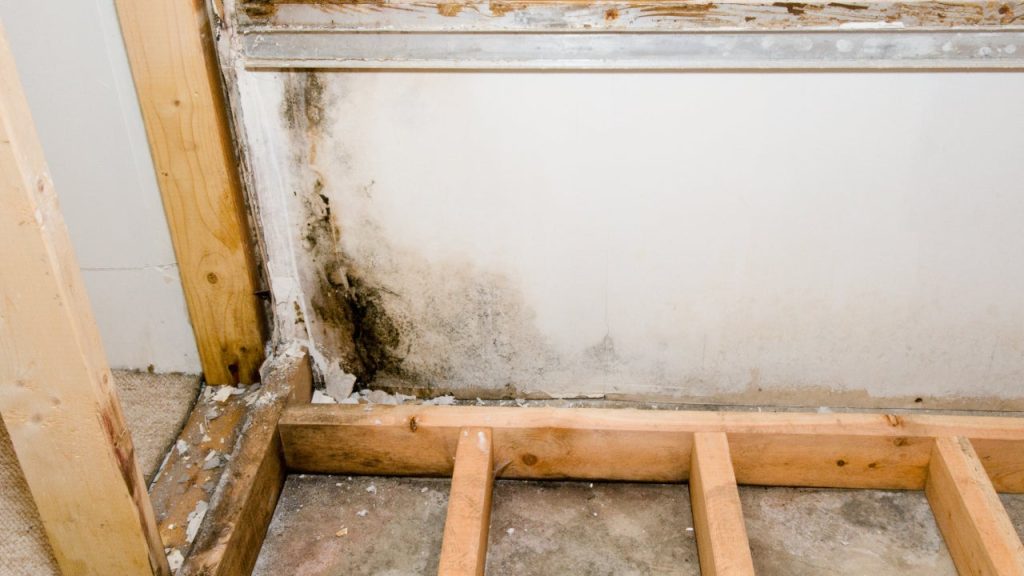Key takeaways
- In most cases, homeowners insurance policies do not cover mold damage as it’s often tied to home maintenance.
- Homeowners insurance policies may provide coverage to remove the mold as part of the mitigation effort to restore your property from a covered peril.
- Mold claims are paid out on a per-claim or aggregate limit basis, depending on how your insurer defines the coverage.
Mold damage is a common exclusion with most home insurance companies. Homeowners are responsible for maintaining their property, and insurance companies consider damage from mold, dry or wet rot and rust preventable through basic household maintenance. However, mold stemming from a covered peril is more likely to have limited coverage, and some providers allow policyholders to purchase coverage for mold remediation by way of endorsement.
Does home insurance cover mold?
In most cases, home insurance does not cover mold. Depending on whether you have a named perils or open perils policy, your insurer will outline which perils are or are not covered in your policy documents. Standard policies cover perils such as lightning, fire, hail, explosions, vandalism, theft, falling objects and the weight of snow. Water damage and its secondary effects (like mold) are a little trickier.
Whether your homeowners insurance covers mold damage depends on how water damage is covered by your policy. The same goes for mold removal or remediation. (Note that remediation is often considered a separate issue by insurance companies.) Check the water and mold clauses of your insurance policy documents to see if mold and/or mold removal are included or excluded from your coverage. If you purchased a mold coverage add-on, the coverage specifics should be listed in more detail in the endorsement section.
Learn more: What does home insurance cover?
Mold caused by covered perils
Your home insurance might cover mold damage resulting from a covered peril. For example, if a tree branch breaks a window in your home during a rainstorm, causing water to soak your floors and walls, you might be covered. Even if you dry the area to the best of your ability, it can take mold up to 18 days to become visible to the naked eye. Your policy may pay to remedy the damage because the storm was a named peril. Similarly, if a burst pipe causes extensive water damage and results in mold, your homeowners policy may provide coverage to remove the mold as part of the mitigation effort to restore your property. Any coverage would be subject to your deductible and any mold coverage limit applied by your property insurer.
Mold caused by flooding
Flooding is one of the main causes of mold damage because it can take a long time for mitigation efforts to begin after a flood. According to the Environmental Protection Agency (EPA), mold growth can begin within 24 to 48 hours after flood damage. Unfortunately, flood damage is not a named peril covered by a standard homeowners policy.
If you didn’t purchase a separate policy or endorsement for flood damage, your homeowners insurance will not cover mold in most flooding cases. An exception would be if you have mold damage or remediation coverage included. Again, this would be detailed in your policy documents.
If you purchased flood insurance through the Federal Emergency Management Agency’s National Flood Insurance Program, policies do not cover mold. Flood insurance through private insurers may differ.
Mold caused by sewer backup
Water damage caused by a sewer backup is not a covered peril on a standard homeowners policy. However, most property insurers will offer an optional sewer backup endorsement, which is typically called water backup and sump pump overflow coverage. If you have purchased this add-on, your policy may extend coverage to mold resulting from the sewer backup through the mitigation process. Still, generally, mold caused by a sewer backup is not covered.
Mold caused by construction or repair
Home insurance usually doesn’t cover mold due to shoddy construction, repairs or poor building materials. If the repair was for a covered claim, there might be coverage since mold can take a while to appear. However, let’s say you discover mold on the wall in the new addition you just added to your home. Your insurance would not cover mold in this case since the proximate cause is not a covered peril. Instead, you would need to seek restitution from the contractor or company hired for the construction work.
Mold caused by negligence
Home insurance companies typically deny claims when the investigation determines that negligence caused the damage. Negligence and wear and tear are excluded from all home policies. Therefore, mold damage caused by negligence would not be covered. Say there is a torrential downpour and you accidentally leave the living room window open, causing a few inches of water to accumulate, resulting in moldy carpet. This would not be covered by insurance, and the repairs would need to be paid for out of pocket.
Why isn’t mold coverage part of a standard home policy?
The industry standard coverage for mold changed about 20 years ago in response to the rise in repeated mold claims. In the late 1990s, several health reports were issued outlining the possible health impact of having mold in the home, starting a public concern coined “The Mold Scare.” At the time, insurance language in policy contracts defining mold coverage was vague, and since mold remediation can cost between $10 to $25 per square foot, companies struggled to handle the influx of expensive mold remediation claims.
Around 2002, the International Organization for Standardization developed wording that states across the U.S. use to clarify and restrict mold coverage. It also provides a structure for insurers to offer policyholders a way to purchase extended coverage.
How is mold covered?
There are two types of mold claims: first-party and third-party. A first-party claim is for mold remediation and repairs to the physical aspect of your home, usually the dwelling, personal property and additional living expenses. A third-party claim is a liability associated with the mold. For instance, a house guest may get ill and have medical expenses due to mold exposure in your home. Also, mold claims are paid out per claim or up to the policy’s aggregate limit, depending on how your insurer defines the coverage.
Every provider is different, so it is essential to read your policy documents and work with your agent to select the right level of mold coverage. Chubb, an insurer specializing in high-end homes, provides coverage for mold remediation resulting from a covered peril as part of its standard insurance policy, with the option to buy more coverage. It also allows policyholders to use their existing liability limit for liability mold claims. Allstate has limited mold coverage as part of its policies, up to $5,000.
Some providers offer separate limits for first- and third-party claims, for example, $2,500 for remediation and $5,000 for liability. Common increased limit options are $25,000 and $50,000 for first-party coverage, and up to $100,000 in liability for third-party coverage.
How to file mold insurance claims
You can file a mold claim the same way you file a regular homeowners insurance claim, with a few slight adjustments. To improve your chances of a successful claim, you need to take every step possible to prevent mold from forming.
Anytime you experience a water loss, act immediately to sanitize and dry the area. Most home policies include coverage for reasonable repairs up to a certain limit. Coverage could be used to move personal property to a safe location to prevent further damage and for the materials you need to remove water and prevent mold from forming. Consider renting a commercial-grade wet/dry vac and portable heater from a local store. By taking the necessary precautions, the claims adjuster can see that you’ve acted responsibly to mitigate the damage, even if unavoidable mold begins to form.
Before filing a claim:
- Stop leaking pipes by shutting off the water to your house.
- Cover damaged areas such as a hole in the roof or a broken window.
- Take photos of all damage, including close-ups and wide shots.
- Dry all affected areas as quickly and thoroughly as possible.
- Remove soaked items such as carpeting, furniture, insulation and mattresses.
- Open doors and windows and use fans to promote faster drying.
- Clean all affected areas with detergent to prevent bacteria spread.
- Contact your insurance agent to file a claim.
- Keep your receipts so the adjuster can reimburse you for reasonable repairs.
Mold can develop within 24 to 48 hours and become visible within 18 to 21 days, even if you have done everything to prevent it — particularly if you live in a humid climate. If mold still appears after the damage is repaired, contact your claims adjuster. Since you have documented the process — and as long as your policy allows for mold claims — your insurer should be able to pay for mold remediation up to the policy limit.
How to prevent mold in your home
Mold is more than a household headache; it can cause serious health problems, too. According to the Centers for Disease Control and Prevention, people with allergies, diseases that weaken the immune system and respiratory diseases face the highest mold-related health risks.
Mold is a common problem, but with proper maintenance, you can prevent mold from getting out of hand. You can often smell the musty odor of mold before you see it or feel a slimy substance when you touch surfaces. Dry mold can grow in linens and pillows and form around dressers, shelves and heating and cooling vents. To prevent mold, regularly follow a few lifestyle and maintenance tips:
- Dry spills immediately.
- Regularly check pipes and appliance hoses for leaks and replace hoses before they spring a leak, if possible.
- Clean non-porous surfaces, like bathroom tile and ceramic floors, with mold-killing products, like bleach.
- Clean porous surfaces like wood with bleach alternatives, such as a hydrogen peroxide and water mixture.
- Install exhaust fans in your kitchen and bathrooms.
- Maintain a humidity level of 30 percent to 60 percent inside your home.
- Paint walls and ceilings with paint that contains mold inhibitors.
- Remove carpets from damp areas, like bathrooms and basements.
- Don’t allow water to accumulate in water reservoirs of house plants.
- Inspect your roof and attic for water seepage and promptly make repairs as necessary.
- Clean debris from gutters to ensure proper water drainage.
- Seal windows and doors to prevent seepage and keep out moisture.
- Allow areas affected by a leak to dry out completely before replacing drywall or flooring.
Frequently asked questions
-
What you pay to get rid of mold in your home will vary depending on where you live, the size of your home, the type of mold, how pervasive the problem is and other factors, like the price of labor in your area. The cost of mold remediation can be high. According to HomeAdvisor’s average actual project costs, the national average for a mold remediation project is $2,362. Bathroom remediation is usually between $500 and $1,000 but can cost upward of $8,000 if the mold damage is extensive. In a basement, you should expect to pay up to $3,000 for mold removal and up to $7,300 to waterproof the space to avoid future problems. If you find mold in your home, contacting an expert in your local area is usually the best way to get an accurate estimate.
-
While bleach may be a good option for solid surfaces in kitchens and bathrooms, it may not be the best option for everyone. Porous surfaces usually can not be cleaned with bleach without causing more damage. Additionally, people with specific allergies or sensitivities may prefer making a DIY mixture. Speaking with a mold expert can help you identify the most effective non-toxic options for the mold in your home.
-
It depends. In general, the time it takes to remove mold from your home will depend heavily on the extent of the mold outbreak and what’s causing it. If you’re trying to get rid of the normal household mold that grows around sinks and in bathrooms, you can typically remove it in a matter of minutes as part of your weekly house cleaning routine. However, if mold is allowed to spread, it could result in a more pervasive issue, which may require numerous hours or days of professional mold removal to rid your home of the issue.
-
If mold isn’t a listed exclusion in your homeowners insurance policy and the provider denies your claim, you can appeal the insurer’s decision. If you believe the insurer has treated you unfairly, you may also file a complaint with your state’s Department of Insurance or the Better Business Bureau. Unfortunately, if your home insurance policy lists mold damage as an exclusion, you’ll likely have no recourse if the insurer denies a mold damage claim.
Read the full article here












